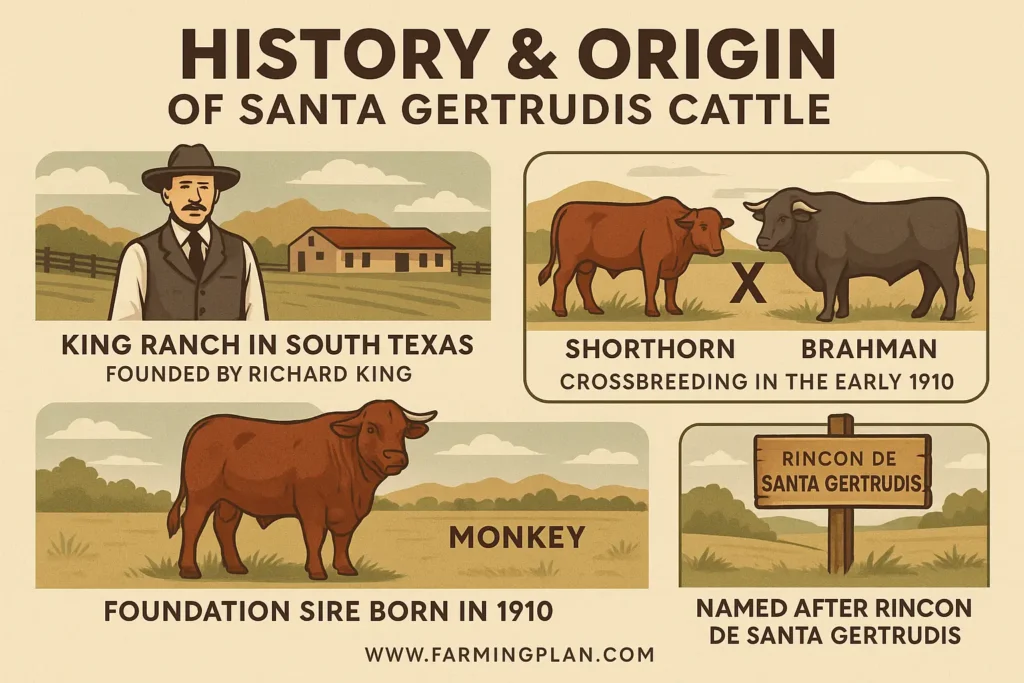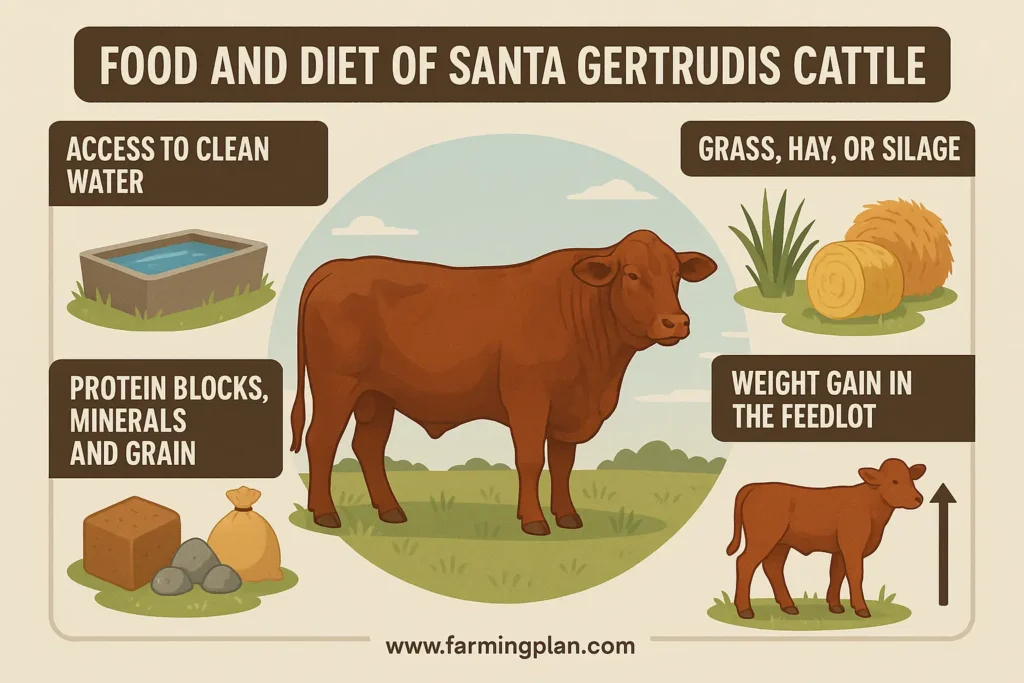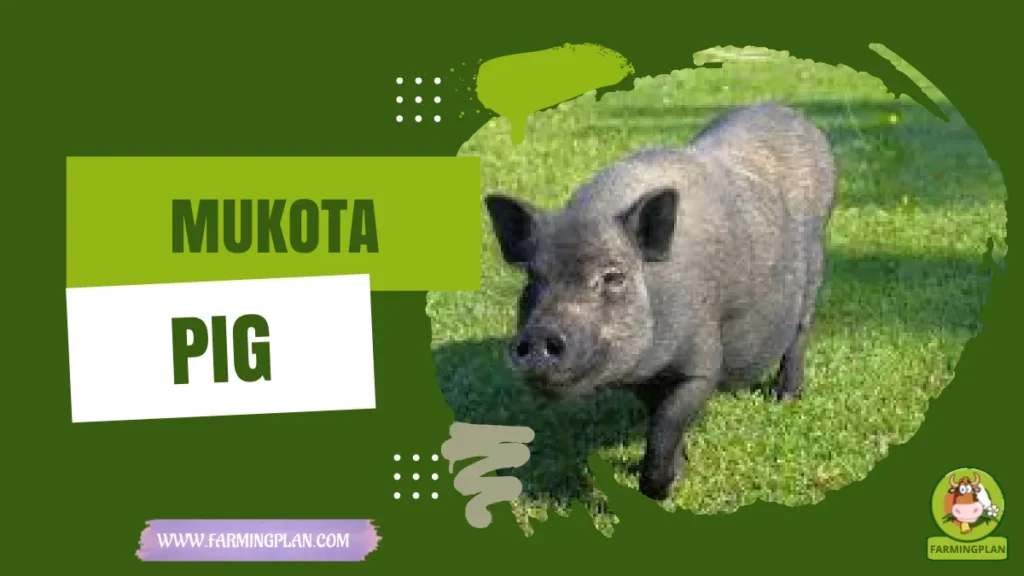Santa Gertrudis cattle are a robust and hardy breed known for their deep cherry-red color, strong build, and ability to thrive in harsh environments. Developed in South Texas on the famous King Ranch, they are the first original beef breed created in the United States. With their unique Brahman and Shorthorn genetics mix, these superior cattle offer excellent growth rates, disease resistance, and feedlot success. Popular among breeders, farmers, and commercial cattlemen, Santa Gertrudis cattle are perfect for anyone looking to raise heavy beef cattle that perform well on native grasses and adapt easily to challenging conditions.

History & Origin of Santa Gertrudis Cattle
The story of Santa Gertrudis cattle begins on the vast and historic King Ranch in South Texas, a region known for its rugged terrain and demanding climate. Richard King founded this ranch and played a significant role in shaping the American cattle industry. In the early 1900s, ranchers at King Ranch began crossbreeding British Shorthorn cattle with Brahman cattle, aiming to create a rugged breed that could withstand heat, insects, and long distances in search of forage.

The breeding program gained momentum when a bull calf born in 1910 showed outstanding traits. This calf, later known as Monkey, became the breed’s foundation sire. He was one-eighth Brahman and seven-eighths Shorthorn—a potent mix defining the Santa Gertrudis breed. Over the next several decades, ranchers worked carefully to stabilize these genetics. In 1940, the Santa Gertrudis was officially recognized as the first original beef breed developed in the United States.
The breed takes its name from the Rincon de Santa Gertrudis, one of the original Spanish land grants that formed the foundation of King Ranch. Today, the legacy of those early cattlemen lives on, as Santa Gertrudis cattle continue to play a vital role in the cattle industry across North and South America, South Africa, and Australia. Their journey from a small breeding herd to a global name in beef production shows how special and successful this breed truly is.
Characteristics
Santa Gertrudis cattle are known for their eye-catching solid cherry-red color, which makes them easy to identify in the field. Their coats are sleek and short, helping them stay cool in hot climates. These heavy beef cattle are large and muscular, with mature bulls often showing a slight hump in the shoulders due to their indicus cattle background. Their frame is strong, their legs are sturdy, and they are built to cover long distances in search of forage without losing condition.
This rugged breed has a smooth blend of Brahman and Shorthorn cattle traits, offering the best of both worlds. The Brahman bloodline contributes to their disease resistance, heat tolerance, and mothering ability, while the Shorthorn side adds muscle, frame, and beef quality. One unique feature is their growth performance—Santa Gertrudis calves show high weight gain per day and reach maturity quickly, often ready for breeding by 12–14 months of age.
Whether used in crossbreeding programs or raised as purebred animals, Santa Gertrudis cattle bring value through strong genetics, uniform appearance, and consistent feedlot success. Their adaptability to unfavorable environments makes them a wise choice for ranchers in dry, hot, or variable climates.
Nature & Temperament
Santa Gertrudis cattle are known for being calm, thoughtful, and easy to handle. Their gentle nature makes them a good match for new and experienced ranchers. Large mature bulls are manageable if raised with care and regular human contact. This makes them ideal for commercial cattle herds, family farms, and youth livestock shows.
These cattle show strong herd instincts and adjust quickly to new places. Whether on open pastures or feedlots, they move well in groups and respond calmly to changes. Their intelligent behavior also helps them remember feeding routines and adapt to new systems. They stay healthy and active in harsh environments thanks to their hardy personalities. They’re known for walking long distances to find food and water without becoming stressed. This makes them especially useful in places where the land is rough, or resources are spread out.
Read More: Afrikaner Cattle: A Unique Breed of Cattle
Food & Diet
Santa Gertrudis cattle thrive on simple, natural diets built to make the most of native grasses and pastures. These strong grazers can survive in areas with limited food supply, thanks to their one-sixteenth Brahman cattle blood. Their ability to travel long distances searching forage makes them perfect for ranchers in dry or hot regions.

To keep them healthy, provide access to clean water and a steady supply of grass, hay, or silage. In rougher seasons or during dry spells, supplement their diet with protein blocks, minerals, and grain if needed. This ensures proper growth, especially for bull calves, replacement cattle, and Santa Gertrudis-cross females being raised for breeding.
This breed performs well in the feedlot. They gain weight quickly and can reach high pounds per day averages when given the right balance of nutrients. Calves can be weaned and started on feed early, showing excellent feed conversion.
Usage & Purpose
Santa Gertrudis cattle are raised mainly for beef production. Their strong build and rapid weight gain make them ideal for producing heavy beef cattle. These cattle are popular among commercial cattlemen and breeding experts because they offer a good return on investment. They grow fast, reach market weight quickly, and deliver superior cattle for the beef industry.
Thanks to their rugged breed background, they are also used in crossbreeding programs to improve the performance of other cattle breeds. The mix of Shorthorn and Brahman genetics helps create calves that are strong, disease-resistant, and fast-growing. This makes Santa Gertrudis-cross females valuable as replacement cattle in many herds.
On large ranches like King Ranch and Freeman Ranch, these cattle play a key role in managing land, producing high-quality show cattle, and improving herd genetics. Their calm nature and good appearance make them a favorite in livestock shows and cattle grants. Santa Gertrudis offers a reliable and profitable option whether you’re building a foundation herd, selling feeder cattle, or improving your cattle pedigrees.
Read More: Arouquesa Cattle: A Farmer’s Guide
Special Features
Santa Gertrudis cattle stand out for several reasons that make them one of the most valued cattle breeds in the world. First, their deep cherry-red color is easy to spot and helps protect them from sun damage. This solid coat color is beautiful and part of their identity across North and South America.
One of the most impressive traits of these cattle is their ability to thrive in demanding environments. These cattle can handle harsh climates, poor pastures, and long walks for food and water. Their Brahman and Shorthorn blood mix creates an optimum blend of heat resistance, strength, and rapid growth.
They are also known for producing heavier calves and high-quality beef. Their bodies are built to convert feed into weight fast, making them popular in feedlots and on large ranches. Bulls and cows pass on strong genetics, so calves often show signs of being outstanding bull calves or successful females.
Another important feature is their natural disease resistance. This helps ranchers reduce medical costs and maintain healthier herds, even in unfavorable environments. Their hardy animal status makes them reliable for commercial cattle herds and heritage cattle programs like the Heritage Beef Cattle Company.
“Santa Gertrudis Cattle Are More Than Just Hardy Animals—they Are A Testament To Resilience, Producing Top-notch Beef Even In The Harshest Environments.”
Health Issues & Prevention
Like all cattle breeds, Santa Gertrudis cattle are susceptible to specific health issues, but their disease-resistant nature makes them less prone to many common problems. The breed’s Brahman genetics contribute to their ability to withstand harsh environmental conditions, reducing the likelihood of heat stress and infections.
However, monitoring their health closely is important, especially in young bulls and replacement cattle. Common health concerns include:
- Foot Rot: This condition can occur if cattle are kept in wet or muddy areas for extended periods. Regular hoof care and maintaining dry conditions help prevent it.
- Respiratory Issues: Cattle may develop respiratory diseases in humid or wet conditions. To avoid this, ensure proper ventilation in barns and sheds.
- Parasites: Internal and external parasites, such as ticks and worms, can affect cattle, especially in warmer climates. Routine deworming and tick control are essential.
Prevention is key to maintaining the health of your Santa Gertrudis cattle. Here are some tips for keeping them healthy:
- Vaccination Programs: Work with a veterinarian to set up a vaccination schedule covering diseases like Bovine Respiratory Disease (BRD) and Blackleg.
- Regular Health Checks: Perform routine physical exams to catch potential issues early, especially for heavier calves or show cattle.
- Proper Nutrition: The right diet ensures strong immune systems and faster recovery from any illness.
- Clean Environment: Keep feeding areas clean and dry and ensure access to fresh water.
Santa Gertrudis cattle can remain healthy and productive for many years with their hardy nature and proper care.
Read More: Aberdeen Angus Cattle: A Breed of Excellence
Step-by-Step Farming Guide for Santa Gertrudis Cattle
Caring for Santa Gertrudis cattle involves understanding their unique needs and ensuring they are well cared for from birth to adulthood. Here’s a simple, step-by-step guide to help you raise them successfully:
Step 1: Prepare the Environment
- Adequate space: Santa Gertrudis cattle are known for traveling long distances in search of forage, so they have plenty of pasture to graze.
- Shelter: While they are hardy and can handle the elements, shelter from extreme weather conditions like heavy rain or intense heat will improve their overall well-being. Shade structures are also a good idea in hot climates.
- Fencing: Secure, sturdy fencing is essential to keep your cattle safe and contained. Ensure the fences are high enough for mature bulls.
Step 2: Nutrition and Feeding
- Grass & Hay: Santa Gertrudis cattle thrive on native grasses and hay. In regions where the forage is limited, they supplement their diet with protein blocks or grains to ensure they receive enough nutrients.
- Water: Access to fresh, clean water is always a must. Make sure water sources are easy for your cattle to access.
- Minerals and Supplements: Adding mineral blocks or salt licks will help provide the necessary nutrients for healthy growth and milk production, especially for replacement cattle and breeding herds.
Step 3: Health Maintenance
- Regular Vaccinations: Establish a vaccination schedule with a veterinarian to protect your cattle from common diseases like BRD and Blackleg.
- Hoof Care: Keep hooves trimmed and healthy to prevent foot rot or other conditions. Regular checks are recommended.
- Deworming: Administer deworming treatments according to the recommended schedule for your region.
Step 4: Breeding and Calving
- Breeding Program: Select bulls and cows with good genetics for feedlot success, heavier calves, and disease resistance. Work with breeders to maintain the optimum blend of genetics for your herd.
- Calving: Be prepared for calving, especially if you have heifer calves. Monitor the process to ensure the calf and mother remain healthy.
Step 5: Handling and Socialization
- Gentle Handling: Train your cattle from a young age to become used to human interaction. Santa Gertrudis cattle are typically calm and easy to handle, but early socialization will make them even more manageable.
- Herd Management: Keep cattle in groups, as they feel safer and more comfortable interacting with others in the herd.
Step 6: Regular Monitoring
- Weight and Growth: Monitor the growth of your bull calves, replacement cattle, and show cattle. Watch for weight gain to ensure they reach their target weight.
- Behavior and Temperament: Even though Santa Gertrudis are known for their calm nature, they always watch for signs of stress, especially when introducing them to new environments.
Following these steps, you can raise healthy, productive Santa Gertrudis cattle that thrive in various environments and provide excellent returns.
FAQ
What is the origin of Santa Gertrudis cattle?
Santa Gertrudis cattle were developed at King Ranch in Texas by Captain Richard King in the early 1900s. They are a cross between Brahman and Shorthorn cattle, making them the first beef breed created in the United States.
What are the primary uses of Santa Gertrudis cattle?
Santa Gertrudis cattle are primarily raised for beef production due to their rapid growth and high-quality meat. They are also used in crossbreeding programs to enhance traits like heat tolerance and disease resistance in other cattle breeds.
How do Santa Gertrudis cattle adapt to hot climates?
Santa Gertrudis cattle have a deep cherry-red coat that helps reflect sunlight and reduce heat absorption. Their Brahman ancestry provides them with sweat glands that aid in cooling, making them well-suited for hot, humid environments.
What is the typical lifespan of Santa Gertrudis cattle?
Santa Gertrudis cattle typically live between 13 to 15 years, with some individuals reaching up to 20 years under optimal care. Their hardy nature contributes to their longevity.
Are Santa Gertrudis cattle disease-resistant?
Yes, Santa Gertrudis cattle are known for their disease resistance, particularly to ticks and heat stress. Their hybrid genetics provide them with enhanced immunity, making them resilient in challenging environments.
Conclusion
Santa Gertrudis cattle are a unique breed developed in Texas for their exceptional beef quality and adaptability to hot climates. Their hybrid lineage combines the strength of Brahman cattle with the meat quality of Shorthorns, resulting in a breed that thrives in demanding environments. With their disease resistance, rapid growth, and docile temperament, Santa Gertrudis cattle are a valuable asset to ranchers seeking a hardy and productive cattle breed.


